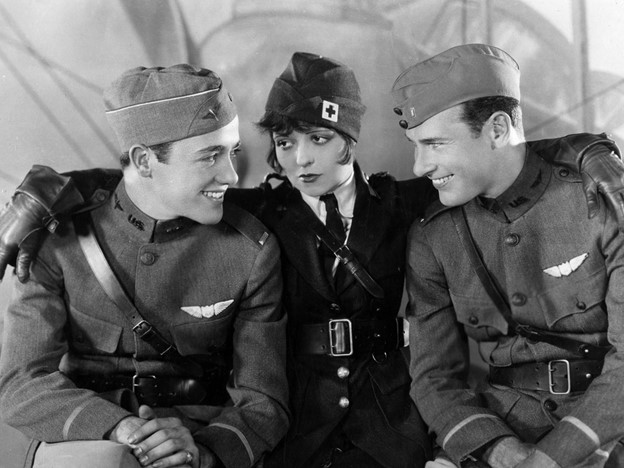Wings (1927)
William A. Wellman's "Wings"
On May 16, 1929, the first-ever Academy Award ceremony was held in the Roosevelt Hotel in Hollywood. The ceremony honored films released from 1927 to 1928. The winner of Best Picture was "Wings," a spectacle film about aviation battles during World War I. The director, William A. Wellman, was not invited because the studio was upset with him for going over budget and over time. However, the reason for the film's immaculate success lies solely in Wellman's direction and management of the production. His cinematic innovations and his technical prowess, especially for capturing aerial combat sequences, made "Wings" the exciting spectacle piece it was.
The plot of the film runs thin. It mainly focuses on two men competing for the same woman as they navigate aerial combat during World War I. However, it is not the plot that makes "Wings" a cinematic triumph. Rather, it is the hard work Wellman put into the production and the realistic battle sequences of aerial combat. In fact, the reason Wellman was hired by Paramount was because he was a combat pilot during World War I. He was the only Hollywood director with the actual experiences portrayed in the film. However, the studio would soon regret their decision. Not because Wellman didn't deliver them a smash hit, which he did. Rather, he went over-budget, over time, and was confrontational with many of the producers tasked with keeping him in line.
Wellman came to Hollywood after he was medically discharged from the French Foreign Legion in 1918. His discharge came after being shot down by Germany's anti-aircraft squad on March 21, 1918. He suffered injuries from the crash and even had a pronounced limp for the rest of his life because of the incident. He came to Hollywood at the request of Douglas Fairbanks, who owned the landing strip Wellman frequently used when coming to California. Fairbanks was so enthralled with Wellman's tales of adventure that he helped Wellman get cast in one of the leading roles of the 1919 film "The Knickerbocker Buckaroo." Wellman didn't take to acting; he considered it an 'unmanly' profession. He instead started getting work behind the camera and eventually worked his way up to a director position.
In 1926, a script for "Wings" was rewritten to accommodate Hollywood's "it" girl at the time, Clara Bow. Wellman was then tasked with directing and chose Kelly Field in San Antonio, Texas as the location for filming. Wellman brought in pilots and planes from the United States Army Air Corps. However, while most Hollywood films typically took over a month to shoot, Wellman spent nine months filming, as many of the aerial sequences were extensive.
To achieve the excitement found in the aerial sequences, Wellman had to wait for perfect sunny days in San Antonio. This meant that there were extensive delays due to inclement weather. There was even an 18-day stretch in which the weather did not permit Wellman to shoot any footage. Not only did the sun have to be out for viewing of the scenes, but Wellman required clouds in the sky. The reason for this was so that the audience could understand the relative speed and dimensions of the planes in flight. As Wellman explained, "Motion on the screen is a relative thing. A horse runs on the ground or leaps over fences or streams. We know he is going rapidly because of his relation to the immobile ground." So, by having clouds in the sky, you can better judge the speeds and directions of the planes, making the action that much more exciting because planes seem to be darting across the sky and past each other.
Clarence S. Irvine, Wellman's adviser, helped Wellman engineer an airborne camera style that allowed for close-ups of the actors during flying. This allowed for more intimate sequences in which personal experiences of the flying could be edited together with the more removed camera shots. Because of this, the sequences are that much more engaging and enthralling. On top of this, the film's use of color process to show the flames and explosions of battling planes made it that much more realistic.
"Wings," despite being low on plot, was a huge commercial and critical success. One of the reasons the public were so drawn to this aerial film was the infatuation with Charles Lindbergh's recent transatlantic flight. However, much of the film's success is due to the immaculate depiction of its aerial sequences, its incredible use of visual effects, and Wellman's ever-inventive camera. In fact, one of the most popular film shots of all time happens in the film, in which the camera pushes past party-goers and lands on our protagonist's drink. All of this culminates in a technical triumph that not only creates visceral excitement due to its stunning spectacle but also a realistic portrayal of aerial combat and wartime conditions.




Comments
Post a Comment